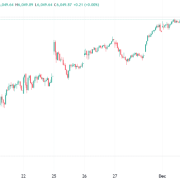
Donald Trump’s recent wave of tax-cut promises and policy proposals is set to increase the US budget deficit by $7.5 trillion over the next decade, according to a new report by the Committee for a Responsible Federal Budget (CRFB).
This estimate is more than double the deficit increase that Kamala Harris’s proposals would generate, projected by the CRFB to widen the deficit by $3.5 trillion.
The CRFB, a nonpartisan organization advocating for fiscal responsibility, highlights that Trump’s combination of tax cuts, increased tariffs, military expansions, and mass deportations all contribute to his fiscal plan’s deep dive into red ink.
Meanwhile, Harris’s fiscal approach is focused on social policy spending, middle-class tax cuts, and tax increases on corporations and high-income households.
Both candidates’ fiscal plans would exacerbate the $22 trillion deficit that the US is already expected to accumulate over the next ten years if no policy changes are made.
Debt levels nearing record highs
The US is already grappling with a debt load that surpasses $28.3 trillion, a figure roughly equivalent to the country’s entire economy.
This debt burden is projected to grow even further, outpacing levels not seen since post-World War II, primarily driven by the aging US population and the structural mismatch between government revenue and spending.
Economists caution that this growing debt could pose significant risks to the economy in the future.
Yet, for now, the US has avoided a fiscal crisis, with solid economic growth continuing despite the ballooning debt.
Source: Committee for a Responsible Federal Budget
Trump’s tax cuts drive the deficit surge
One of the key factors behind Trump’s massive deficit projections is his focus on tax cuts.
In addition to extending his 2017 tax cuts, which are set to expire at the end of next year, Trump has made sweeping promises to eliminate taxes on tips, Social Security benefits, and overtime pay.
He also vowed to restore the deduction for state and local taxes, which was capped at $10,000 by the 2017 tax law.
Despite these significant tax cuts, Trump’s energy policies and tariffs do little to balance the deficit impact. Marc Goldwein, senior vice president of the CRFB, said,
“President Trump started promising a new tax cut at every rally, and those really added up.”
His promises have driven his projected deficit increase much higher than Harris’s over a short period.
Six weeks ago, the two candidates had similar fiscal strategies, but Trump’s aggressive tax-cut pledges have shifted the balance, pushing his plan into significantly deeper deficit territory.
Harris’s more moderate deficit impact
While Kamala Harris’s economic proposals would also widen the deficit, her $3.5 trillion estimate is considerably lower than Trump’s.
Harris’s plan includes expanded tax credits for families with children and first-time homebuyers, new investments in paid leave and child care, and maintaining tax cuts for households earning under $400,000.
She also supports raising taxes on corporations and high-income individuals to offset some of these expenditures.
Although Harris has advocated for deficit reduction in her policy agenda, CRFB analysts believe this will be difficult to achieve, given the broad opposition to higher taxes.
As Marc Goldwein noted, “The menu of offsets is a lot of really, really hard stuff.”
Source: Committee for a Responsible Federal Budget
Neither plan stabilizes the national debt
While both Trump and Harris have proposed measures that could stimulate economic growth, their plans also contain elements that would counteract those benefits.
Trump’s tariffs, for instance, could hurt growth, while Harris’s tax increases on the wealthy may dampen investment.
According to the CRFB, under both candidates’ plans, the national debt would continue to grow faster than the economy.
“Obviously, neither of them are moving in the direction of stabilizing the debt,” Goldwein said.
With the deficit already on track to exceed $22 trillion over the next decade, the growing debt remains a looming challenge for whoever takes the presidency in the upcoming election.
Whether the candidates will adjust their fiscal strategies in response to economic realities remains uncertain, but the current projections paint a concerning picture of America’s long-term financial health.
The post Trump’s budget plan will increase deficit by $7.5T, twice the size of Harris’ proposal, CRFB study finds appeared first on Invezz











